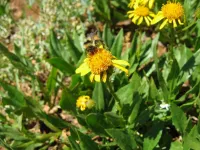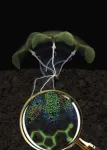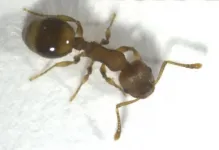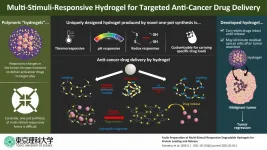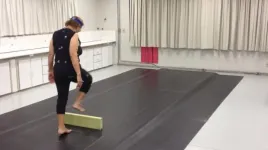(Press-News.org) CHARLOTTESVILLE, Va. -- If, as the saying goes, less is more, why do we humans overdo so much?
In a new paper featured on the cover of Nature, University of Virginia researchers explain why people rarely look at a situation, object or idea that needs improving -- in all kinds of contexts -- and think to remove something as a solution. Instead, we almost always add some element, whether it helps or not.
The team's findings suggest a fundamental reason that people struggle with overwhelming schedules, that institutions bog down in proliferating red tape, and, of particular interest to researchers, that humanity is exhausting the planet's resources.
"It happens in engineering design, which is my main interest," said Leidy Klotz, Copenhaver Associate Professor in the Department of Engineering Systems and Environment. "But it also happens in writing, cooking and everything else -- just think about your own work and you will see it. The first thing that comes to our minds is, what can we add to make it better. Our paper shows we do this to our detriment, even when the only right answer is to subtract. Even with financial incentive, we still don't think to take away."
Klotz, whose research explores the overlaps between engineering and behavioral science, teamed with three colleagues from the Batten School of Leadership and Public Policy on the interdisciplinary research that shows just how additive we are by nature. Batten public policy and psychology faculty, assistant professor Gabrielle Adams and associate professor Benjamin Converse, and former Batten postdoctoral fellow Andrew Hales, collaborated with Klotz on a series of observational studies and experiments to study the phenomenon.
When considering two broad possibilities for why people systematically default to addition -- either they generate ideas for both possibilities and disproportionately discard subtractive solutions or they overlook subtractive ideas altogether -- the researchers focused on the latter.
"Additive ideas come to mind quickly and easily, but subtractive ideas require more cognitive effort," Converse said. "Because people are often moving fast and working with the first ideas that come to mind, they end up accepting additive solutions without considering subtraction at all."
The researchers think there may be a self-reinforcing effect.
"The more often people rely on additive strategies, the more cognitively accessible they become," Adams said. "Over time, the habit of looking for additive ideas may get stronger and stronger, and in the long run, we end up missing out on many opportunities to improve the world by subtraction."
Klotz has a book that takes a wider view of the topic, Subtract: The Untapped Science of Less, coming out a week after the Nature paper. Although the timing is coincidence, both the paper and book are products of the interdisciplinary and collaborative research environment at UVA, he said.
"It's an incredibly interesting finding, and I think our research has tremendous implications across contexts, but especially in engineering to improve how we design technology to benefit humanity," Klotz said.
The researcher's findings are also described in this video produced by Nature.
INFORMATION:
About UVA Engineering: As part of the top-ranked, comprehensive University of Virginia, UVA Engineering is one of the nation's oldest and most respected engineering schools. Our mission is to make the world a better place by creating and disseminating knowledge and by preparing future engineering leaders. Outstanding students and faculty from around the world choose UVA Engineering because of our growing and internationally recognized education and research programs. UVA is the No. 1 public engineering school in the country for the percentage of women graduates, among schools with at least 75 degree earners; the No. 1 public engineering school in the United States for the four-year graduation rate of undergraduate students; and the top public engineering school in the country for the rate of Ph.D. enrollment growth since 2015. Learn more at engineering.virginia.edu.
About UVA's Department of Engineering Systems and Environment: As the home of civil, systems and environmental engineering at UVA, the department combines research expertise in cyber-physical and systems approaches with deep domain knowledge in such areas as transportation, the environment, human health, defense and public safety. Our research focus areas are 1) health care systems engineering, 2) smart cities, 3) environmental engineering, 4) intelligent decision and control systems, 5) systems assurance and resilience and 6) cyber-human systems. Beyond developing or improving new technologies, Engineering Systems and Environment is committed to understanding how people might use engineering systems and the opportunities these systems present for societal impact. Learn more at engineering.virginia.edu/ese.
About UVA's Frank Batten School of Leadership and Public Policy: At the Batten School, we are committed to solving the world's toughest policy challenges. We know the complex issues of our time demand innovative, collaborative, cross-sector relationships within our walls and beyond. Our multidisciplinary approach to problem-solving and emphasis on ethics reinforce our focus on how leadership works, why context matters in decision-making and which actions lead to tangible results. Learn more at batten.virginia.edu.
Mobility tracking using cell phone data showing greater movement of people is a strong predictor of increased rates of COVID-19, according to new data in CMAJ (Canadian Medical Association Journal).
"This study shows that mobility strongly predicts [severe acute respiratory syndrome coronavirus 2] SARS-CoV-2 growth rate up to 3 weeks in the future, and that stringent measures will continue to be necessary through spring 2021 in Canada," writes Dr. Kevin Brown, Public Health Ontario, with coauthors.
Until Canadians are widely vaccinated against SARS-CoV-2, nonpharmaceutical public health interventions such as physical distancing and limiting social contact will be the main population-based means of controlling the spread of the virus.
"Mobility ...
While studying genetic diversity in bumblebees in the Rocky Mountains, USA, researchers from Uppsala University discovered a new species. They named it Bombus incognitus and present their findings in the journal Molecular Biology and Evolution.
Bumblebees are vital for agriculture and the natural world due to their role in plant pollination. There are more than 250 species of bumblebee, and they are found mainly in northern temperate regions of the planet. Alarmingly, many species are declining due to the effects of climate change, and those with alpine and arctic habitats are particularly threatened. However, the full diversity of bumblebee ...
The hormone auxin is of central importance for the development of plants. Scientists at the University of Bayreuth and the Max Planck Institute for Developmental Biology in Tübingen have now developed a novel sensor that makes the spatial distribution of auxin in the cells of living plants visible in real time. The sensor opens up completely new insights into the inner workings of plants for researchers. Moreover, the influences of changing environmental conditions on growth can now also be quickly detected. The team presents its research results in the journal Nature.
The effects of the plant hormone auxin were first described ...
Ants react to social isolation in a similar way as do humans and other social mammals. A study by an Israeli-German research team has revealed alterations to the social and hygienic behavior of ants that had been isolated from their group. The research team was particularly surprised by the fact that immune and stress genes were downregulated in the brains of the isolated ants. "This makes the immune system less efficient, a phenomenon that is also apparent in socially isolating humans - notably at present during the COVID-19 crisis," said Professor Susanne Foitzik, who headed up the study at Johannes ...
Cancer therapy in recent times relies on the use of several drugs derived from biological sources including different bacteria and viruses, among others. However, these bio-based drugs get easily degraded and therefore inactivated on administration into the body. Thus, effective delivery to and release of these drugs at target tumor sites are of paramount importance from the perspective of cancer therapy.
Recently, scientists have discovered unique three-dimensional, water-containing polymers, called hydrogels, as effective drug delivery systems (DDSs). Drugs loaded into these hydrogels remain relatively stable owing to the network-like structure and organic tissue-like consistency of these DDSs. Besides, drug release from hydrogels can ...
By Karina Ninni | Agência FAPESP – A multidisciplinary research group affiliated with the Department of Physical Education’s Human Movement Laboratory (Movi-Lab) at São Paulo State University (UNESP) in Bauru, Brazil, measured step length synergy while crossing obstacles in patients with Parkinson’s disease and concluded that it was 53% lower than in healthy subjects of the same age and weight. Step length is one of the main variables affected by the disease.
Synergy, defined as combined operation, refers in this case to the capacity of the locomotor (or musculoskeletal) system to adapt movement while crossing an obstacle, combining factors such as speed and foot position, for example. Improving synergy in Parkinson’s patients while they ...
You might not think an animal made out of stone would have much to worry about in the way of predators, and that's largely what scientists had thought about coral. Although corallivores like parrotfish and pufferfish are well known to biologists, their impact on coral growth and survival was believed to be small compared to factors like heatwaves, ocean acidification and competition from algae.
But researchers at UC Santa Barbara have found that young corals are quite vulnerable to these predators, regardless of whether a colony finds itself alone on the reef or surrounded by others of its kind. The research, led by doctoral student Kai Kopecky, appears in the journal Coral Reefs.
Kopecky and his co-authors ...
Unusual diseases are medical mysteries that fascinate us, and one such disease is multiple system atrophy, or MSA. This rare neurological disorder causes failures in the proper functioning of the body's autonomic system (processes that are not under our conscious control, such as blood pressure, breathing, and involuntary movement). The resulting symptoms can look like two other types of neurodegenerative disease: Parkinson's disease and cerebellar ataxia. In fact, MSA can be separated into a parkinsonism subtype or a cerebellar subtype based on whether the resultant movement-related ...
Within multicellular organisms, cells build connections with each other forming cell layers that cover the surfaces of tissues and organs and separate structures in the body. For example, the skin forms a mantle around the entire organism, and the layer of cells lining the blood vessels creates a boundary between the bloodstream and tissues. Special connections between neighbouring cells ensure that these cellular barriers are, on the one hand, stable and tight - thus protecting the body and organs against pathogens - while, on the other hand, they remain permeable to specific substances or migrating cells. This is how the cells allow dissolved ...
Imagine the process of distributing electricity to homes from the power grid is like travelers boarding a train.
There are multiple steps to take before they can reach their final destination. First, they have to buy a ticket at the ticketing booth - this is where the power is generated. Then, they board a train that departs from the station - the power is transmitted over distances using transmission lines. Finally, the train takes the travelers (electricity) to their final destination. This final step of sending power to homes and businesses is called the distribution system - and it is critical that ...

